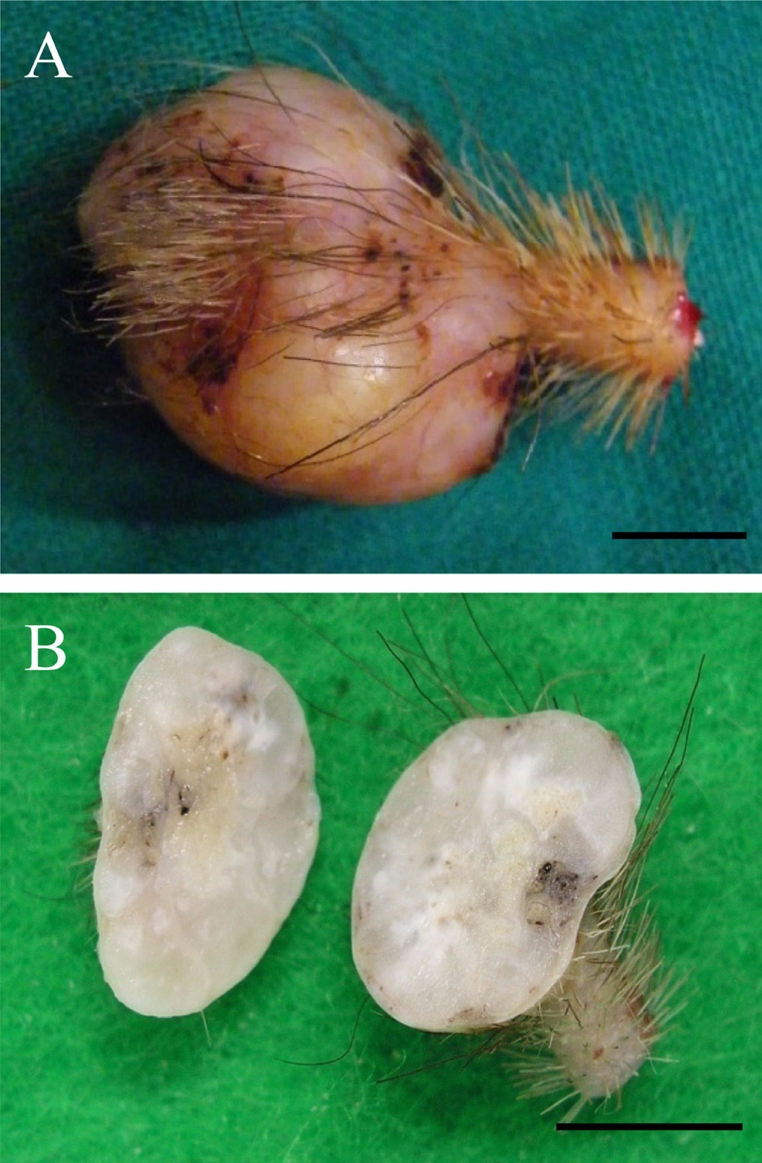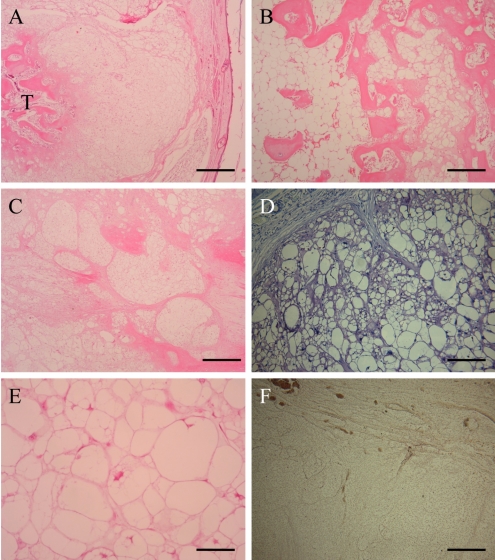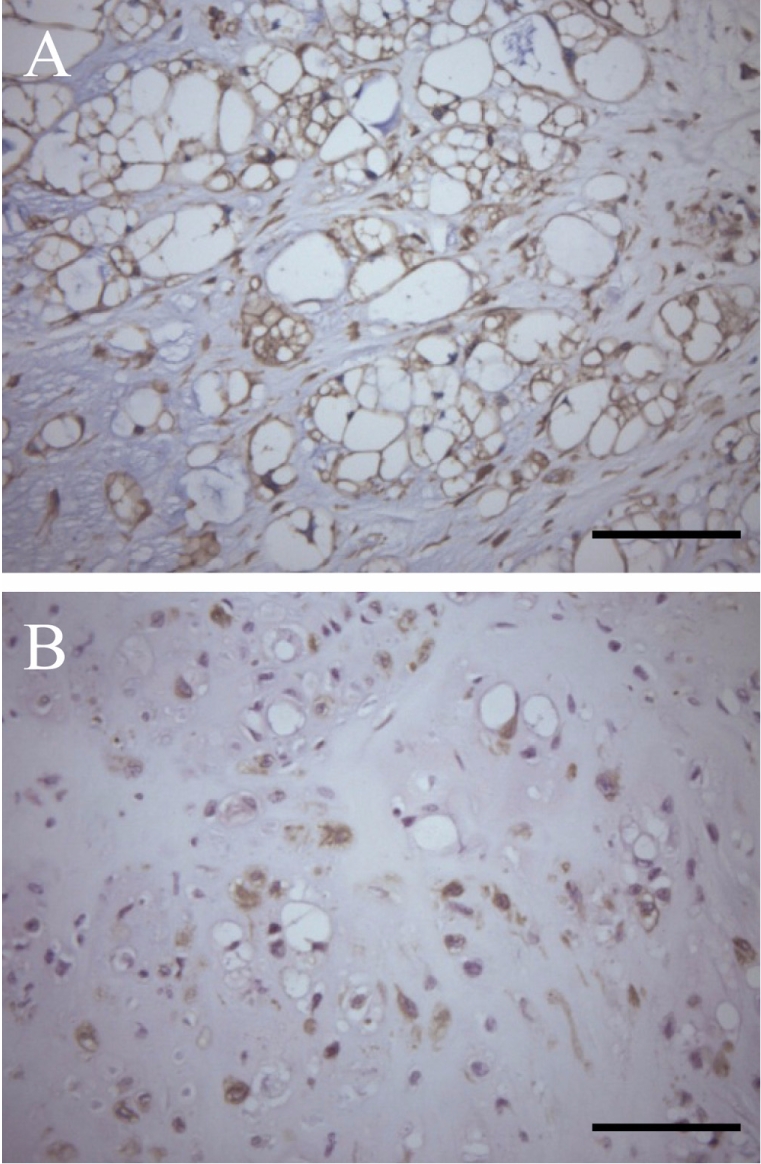Lab Anim Res.
2011 Mar;27(1):53-57. 10.5625/lar.2011.27.1.53.
Chordoma in the Tail of a Ferret
- Affiliations
-
- 1College of Veterinary Medicine & Graduate School of New Drug Discovery and Development, Chungnam National University, Daejeon, Republic of Korea. hyson@cnu.ac.kr
- KMID: 2391859
- DOI: http://doi.org/10.5625/lar.2011.27.1.53
Abstract
- A chordoma is an uncommon tumor that originates from the remnants of the notochord and most commonly involves the cranial and caudal regions of the axial skeleton. Chordoma has been described in laboratory animals such as dogs, rats, minks, and ferrets. This report describes a case of a chordoma in the tail of a ferret. Grossly, a grayish-white, expansile, subcutaneous soft-tissue mass was observed in the tail. Histopathologically, the mass was a loosely placed, nodular, unencapsulated neoplasm within the dermis. In the mass, tumor lobules were intermingled with fibrous tissues. Fibrous tissues contained abundant extracellular basophilic material that was consistent with mucin. The tumor was composed of a close pack of adipocyte-like vacuolated cells (physaliferous cells). The cells were centrally or eccentrically located round nuclei and eosinophilic cytoplasm with large vacuoles. Immunohistologically, neoplastic cells were positive for vimentin and S-100 protein. Based on histopathologic findings and special staining characteristics, this case was diagnosed as chordoma.
Keyword
MeSH Terms
Figure
Reference
-
1. Ball V, Auger L. Les chordomas su tumeurs de la dorsal chez l'homme et les animaux. Rev Vet Zootech. 1933; 85:185–195.2. Carminato A, Marchioro W, Melchiotti E, Vascellari M, Mutinelli F. A case of coccygeal chondroid chordoma in a cat: morphological and immunohistochemical features. J Vet Diagn Invest. 2008; 20(5):679–681. PMID: 18776111.
Article3. Carpenter JL, Stein BS, King NW Jr, Dayal YD, Moore FM. Chordoma in a cat. J Am Vet Med Assoc. 1990; 197(2):240–242. PMID: 2384326.4. Dunn DG, Harris RK, Meis JM. Sweet DE. A histomorphologic and immunohistochemical study of chordoma in twenty ferrets (Mustela putorius furo). Vet Pathol. 1991; 28(6):467–473. PMID: 1722924.5. Zaki FA. Spontaneous central nervous system tumors in the dog. Vet Clin North Am. 1977; 7(1):153–163. PMID: 191973.
Article6. Hadlow WJ. Vertebral chordoma in two ranch mink. Vet Pathol. 1984; 21(5):533–536. PMID: 6485214.
Article7. Heffelfinger MJ, Dahlin DC, MacCarty CS, Beabout JW. Chordomas and cartilaginous tumors at the skull base. Cancer. 1973; 32(2):410–420. PMID: 4722921.
Article8. Herron AJ, Brunnert SR, Ching SV, Dillberger JE, Altman NH. Immunohistochemical and morphologic features of chordomas in ferrets (Mustela putorius furo). Vet Pathol. 1990; 27(4):284–286. PMID: 2402855.9. Ishida T, Dorfman HD. Chondroid chordoma versus low-grade chondrosarcoma of the base of the skull: can immunohistochemistry resolve the controversy? J Neurooncol. 1994; 18(3):199–206. PMID: 7525890.
Article10. Jabara AG, Jubb KV. A case of a probable chordoma in a dog. Aust Vet J. 1971; 47(8):394–397. PMID: 5106797.
Article11. Koestner A, Bilzer T, Fatzer R, Schulman FY, Summers BA, Van Winkle TJ. Schulman FY, editor. Local extensions of regional tumors. World Health Organization Histologic Classification of Tumors of Domestic Animals. 1999. 2nd ed. Washington DC: Armed Forces Institute of Pathology;p. 35–36.12. Koestner A, Higgins RJ. Meuten DJ, editor. Tumors of the nervous system. Tumors in Domestic Animals. 2002. 4th ed. Iowa: Iowa State Press;p. 728–729.
Article13. Maher JA, DeStefano J. The ferret: an animal model to study influenza virus. Lab Anim (NY). 2004; 33(9):50–53. PMID: 15457202.
Article14. Munday JS, Brown CA, Richey LJ. Suspected metastatic coccygeal chordoma in a ferret (Mustela putorius furo). J Vet Diagn Invest. 2004; 16(5):454–458. PMID: 15460332.15. Munday JS, Brown CA, Weiss R. Coccygeal chordoma in a dog. J Vet Diagn Invest. 2003; 15(3):285–288. PMID: 12735353.
Article16. Nakajima T, Watanabe S, Sato Y, Kameya T, Hirota T, Shimosato Y. An immunoperoxidase study of S-100 protein distribution in normal and neoplastic tissues. Am J Surg Pathol. 1982; 6(8):715–727. PMID: 6301296.
Article17. Pease AP, Berry CR, Mott JP, Peck JN, Mays MB, Hinton D. Radiographic, computed tomographic and histopathologic appearance of a presumed spinal chordoma in a dog. Vet Radiol Ultrasound. 2002; 43(4):338–342. PMID: 12174996.
Article18. Stefanski SA, Elwell MR, Mitsumori K, Yoshitomi K, Dittrich K, Giles HD. Chordomas in Fischer 344 rats. Vet Pathol. 1988; 25(1):42–47. PMID: 3344569.
Article19. van den Brand JM, Stittelaar KJ, van Amerongen G, Rimmelzwaan GF, Simon J, de Wit E, Munster V, Bestebroer T, Fouchier RA, Kuiken T, Osterhaus AD. Severity of pneumonia due to new H1N1 influenza virus in ferrets is intermediate between that due to seasonal H1N1 virus and highly pathogenic avian influenza H5N1 virus. J Infect Dis. 2010; 201(7):993–999. PMID: 20187747.
Article20. Volpe R, Mazabraud A. A clinicopathologic review of 25 cases of chordoma (a pleomorphic and metastasizing neoplasm). Am J Surg Pathol. 1983; 7(2):161–170. PMID: 6859391.21. Williams BH, Eighmy JJ, Berbert MH, Dunn DG. Cervical chordoma in two ferrets (Mustela putorius furo). Vet Pathol. 1993; 30(2):204–206. PMID: 7682370.22. Willis LS, Barrow M. The ferret (Mustela putorius furo L.) as a laboratory animal. Lab Anim Sci. 1971; 21(5):712–716. PMID: 4329234.




